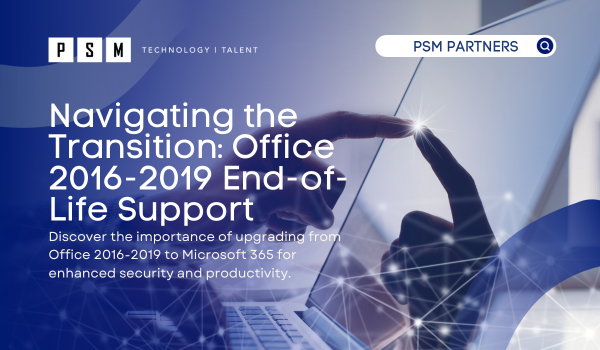Table of Contents
ToggleThe Microsoft Office Suite has been a cornerstone of productivity for businesses, students, and individuals worldwide for several decades. Its suite of familiar applications, such as Word, Excel, PowerPoint, and Outlook, has not only revolutionized the way we work but has also become synonymous with efficiency and productivity. In an ever-evolving technological landscape, software constantly undergoes transformations and improvements to meet the changing needs of its users. Microsoft’s Office 2016 and Office 2019 have now reached the end of their support lifecycle. This pivotal moment in the software’s history raises questions and concerns about the implications of this transition.
In this blog, we’ll explore the implications of this transition and why it’s crucial for businesses, students, and individuals to upgrade to the latest version of Microsoft Office, now known as Microsoft 365 (M365). We’ll uncover the risks associated with using outdated software, the benefits of staying current, and the steps you can take to make a seamless and secure transition to the newest Office suite. Whether you’re a professional aiming to maintain a competitive edge, a student striving for academic success, or an individual looking to enhance your productivity, understanding the importance of this upgrade is paramount.
What Does End-of-Life Support Mean
It’s essential to understand what “end-of-life support” means. End-of-life support marks the point in time when Microsoft discontinues updates, security patches, and technical support for a specific software version. While older Office versions may technically establish connections with Microsoft 365 services, this compatibility is not officially endorsed. This is a critical juncture, as it leaves users vulnerable to potential security risks and compatibility issues. It’s the equivalent of using an outdated road map in a rapidly changing landscape; you’re likely to miss out on new features, optimizations, and security measures. For the optimal experience when using Microsoft 365 services, it is strongly recommended transitioning from older Office versions to those officially supported for seamless integration with Microsoft 365 services.
End of support event | End of support date |
Office 2013 | April 11, 2023 |
Office 2016 | October 14, 2025 |
Office 2019 connectivity to Microsoft 365 services | October 10, 2023 |
The Evolution of Office: From 2016 to 2019
Prior to exploring the implications of the end-of-life support for Office 2016-2019, it’s crucial to grasp the significance of these two major releases.
Office 2016:
Launched in September 2015, Office 2016 marked a significant milestone with its array of innovative features and enhancements, focusing on collaboration, seamless cloud integration, and enhanced mobile capabilities. This version of the Office suite was meticulously crafted to meet the evolving needs of businesses and individuals alike. With its emphasis on collaboration, teams could work together more efficiently, sharing documents and ideas in real time. The deep integration of cloud services facilitated seamless access to files from anywhere, fostering flexibility and productivity. Furthermore, the robust mobile capabilities ensured that users could stay productive on the go, empowering a new era of mobile work. These advancements not only streamlined workflows but also laid the foundation for a more connected and efficient work environment, making Office 2016 a game-changer for users seeking enhanced productivity and collaboration tools.
The End-of-Life phase for Office 2016 is a crucial aspect that users must take into consideration. Mainstream support for this version officially concluded on October 13, 2020, marking the end of regular updates, feature improvements, and complimentary assistance from Microsoft. However, the software is currently in its Extended support phase, set to conclude on October 14, 2025. During this period, users will still receive security updates and bug fixes, but the termination of these services in 2025 underscores the pressing need to transition to a more recent version to ensure continued security, compatibility, and optimal performance.
Office 2019:
Office 2019, released in September 2018, provided a distinct alternative for users who favored a one-time purchase model over subscription-based services like Office 365. Unlike its subscription-based counterpart, Office 2019 allowed users to make a single, upfront purchase, granting them access to the suite without ongoing subscription fees. This release introduced several enhancements, incorporating features from Office 365 that were not available in Office 2016. By offering a more traditional software purchasing option, Office 2019 catered to individuals and businesses seeking a stable and reliable productivity solution without the commitment of ongoing subscriptions.
The End-of-Life timeline for Office 2019 is crucial for users seeking long-term reliability and security. Notably, the mainstream support phase for this version concluded on October 10, 2023, signifying the end of regular updates, feature improvements, and comprehensive assistance from Microsoft. Although there’s a grace period in the form of Extended support, this too is scheduled to cease on October 14, 2025. During this period, users will continue to receive crucial security updates and bug fixes, ensuring a certain level of stability. However, the imminent conclusion of Extended support underscores the importance of transitioning to a more current version before the specified date. Being mindful of these milestones is essential for users aiming to maintain a secure and efficient digital workspace.
Why Upgrade to Microsoft 365 (Formerly Office 365): Benefits and Features
The implications of the end-of-life support underscore the significance of transitioning to a more up-to-date Office version. Let’s delve into the compelling motivations for making this change:
- Enhanced Security:
An upgrade guarantees the prompt delivery of crucial security updates. Safeguarding your data and systems against ever-evolving cyber threats should stand as a paramount concern.
- Improved Productivity:
Recent editions offer enhanced features, user interfaces, and collaboration tools. These improvements can greatly enhance your efficiency, streamline work processes, and significantly boost productivity.
- Compatibility:
Upgrading ensures seamless compatibility with files and documents created in newer Office versions. You won’t face the hassle of format conversions or compatibility issues, enabling smoother collaboration with colleagues and partners.
- Long-term Support:
Newer editions usually offer extended support, ensuring you won’t encounter another end-of-life support scenario in the near future. This stability is especially invaluable for businesses.
- Access to New Features:
Microsoft continues to innovate and introduce exciting features that make your work more efficient and enjoyable. Features like Microsoft Teams integration, advanced AI capabilities, and enhanced data analysis tools are among the advantages of staying current.
How to Seamlessly Upgrade to Microsoft 365
If you’ve decided that an upgrade is the appropriate choice for you or your company, here’s the process to follow:
- Office 365 Subscription:
Microsoft’s Office 365 (Microsoft 365) is a subscription-based service that ensures you’re always using the latest version of Office. It comes with automatic updates, cloud storage, and a suite of collaboration tools, making it a comprehensive productivity solution.
- Office 2021:
Microsoft has also released a standalone version of Office called Office 2021, available as a one-time purchase. While it doesn’t offer the same continuous updates as Office 365, it provides a more traditional software purchasing option.
- Migration Plan (For Companies):
Migrating to a new Office version in an organizational setting can be a complex process. A well-planned migration strategy is crucial to minimize disruptions. This may involve assessing compatibility, training employees, and gradually transitioning to the new version.
- Data Backup:
Prior to the upgrade, it’s crucial to create backups of all your vital data, files, and configurations. This step guarantees the preservation of critical information throughout the migration.
How PSM Partners Can Facilitate Your Transition to Microsoft 365
As technology progresses, it’s imperative to keep your software up to date to maintain security, compatibility, and productivity. Office 2016-2019 served users well, but their end-of-life support signals the need for a transition to newer versions of Office. Whether you opt for Office 365 or Office 2021, upgrading is a significant step toward a more efficient and secure work environment. Don’t wait until it’s too late – embrace the future of Office productivity today and ensure that you’re equipped to face the ever-evolving demands of the digital age. At PSM Partners, we specialize in managed Microsoft 365 services, assisting businesses and institutions in optimizing their subscriptions. If your organization aims to leverage cloud storage, our experts provide Office 365 migration services to seamlessly transfer your data to the cloud. Microsoft 365’s cloud storage offers ample space for your data, freeing up room on your computers and local storage devices. We excel in setting up your cloud infrastructure and ensuring a secure and smooth migration process. Upgrading is not merely a necessity; it’s an opportunity to unlock new potential and possibilities for your work and collaborations. To learn more, call PSM at (312) 940-7830 today.
Related Insights
What are LOLBins: The Growing Threat
Cybercriminals are becoming increasingly clever at turning everyday tools into...
Read MoreUpcoming Cybersecurity Events in 2026
As technology continues to evolve at a rapid pace, staying...
Read MoreCybersecurity Awareness Month: How to Protect Yourself from Online Threats
Every October, Cybersecurity Awareness Month serves as a reminder of...
Read MoreCybersecurity Trends in Higher Education: What Colleges and Universities Need to Know
Key Takeaways: Your Cybersecurity Questions Answered Higher Education Is Now...
Read More




